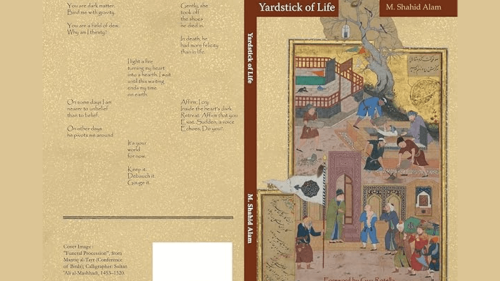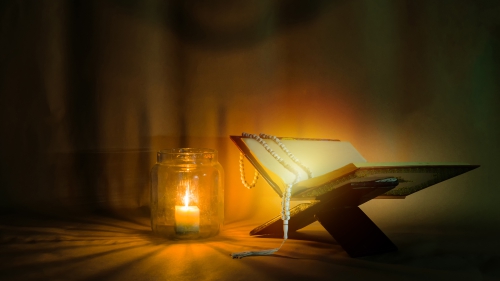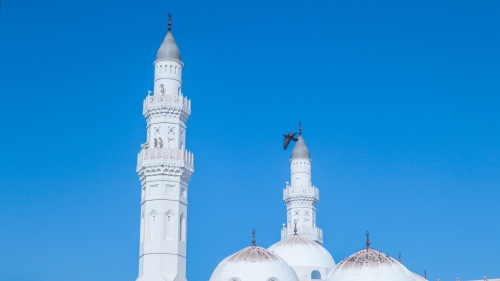Al-Qarawiyyin: World's Oldest University

Introduction
For well over twelve hundred years Al-Qarawiyyin has been one of the leading spiritual and educational centers of the Muslim World, a typical institution, of many, underlining how learning constituted the heart of the religion of Islam and its civilization.
The story of its foundation is also revealing. It was founded in 859 C.E., by a young princess named Fatima Al-Fihri who migrated with her father Mohammed Al-Fihri form Qayrawan (Tunisia) to Fez. The family joined a community of other migrants from Qayrawan "Qayrawaniyyins", who settled in a western district of Fez. Fatima and her sister Mariam, who were well educated and brought up with religious devotion, inherited a large amount from their father who was a successful businessman. Fatima vowed to spend her entire inheritance on building a mosque suitable for her community. This remarkable story is a typical example shedding some light on the role and contribution of women in Muslim civilization. Such a role is the subject of widely held misconceptions about Islam.
 |
| Figure 1: The Almohad chandelier was made from the bronze of a giant bell won in a battle at Gibraltar. |
Because of its location, the mosque became known as Al-Qairawaniyyin Mosque, slowly shortened into Al-Qarawiyyin[1] . Originally the mosque was built to be a medium size, about 30m long with four transversal aisles. The courtyard was located to the west of the prayer hall, with the minaret standing in its middle adjoining the external wall[2]. This minaret is in the rear of the Mosque opposite the mihrab and qibla wall in a similar fashion to those found in Qayrawan and the Great Mosque of Cordoba. Briefly, Al-Qarawiyyin had the religious function of any mosque as well as the teaching of the traditional Islamic sciences - hadith, tafsir, fiqh.
Structural and Formal Evolution of the Mosque
The present form of the mosque has evolved through many phases when it was subject to alteration and extension to meet the increasing need for worship space of a fast growing population.
The first extension phase was undertaken in 956 C.E., a century after the mosque's foundation, by the Zenata leaders[3]. Historic sources revealed that the Umayyad Caliph of Cordoba, Abdul-Rahman III sent a large sum of money to cover the cost of these works. The works extended from the prayer hall to the east and west pushing the original courtyard further back to the west. The minaret, with its square form, that became typical of North African (Maghribi) minarets, was relocated to the northern wall. The mu'azzin of Qarawiyyin is known to be the first in the history of Fez to climb to the top of the minaret to call for prayer. It became a tradition that other mosques of the city would make this call only after they hear the Qarawiyyin, a tradition which is still preserved today.
 |
| Figure 2: Internal view of the prayer hall at Al-Qarawiyyin. |
More works were carried out under the Almuravid (Almurabitun) patronage. In 1135, the Emir Ali Ibn Yusuf ordered the extension of the mosque from 18 to 21 aisles, bringing its area for the first time to more than 3000 square metres[4]. Some views suggested that Ali Ibn Yusuf brought two Andalusian architects, who constructed the central aisle (nave) of the Mosque as well as that of the Great Mosque of Telemcen (Algeria, 1136). With this extension a new mihrab was pierced in the Qibla wall. Much of its character resembles the Cordoban type with its horseshoe arch and an ijmiz frame decorated with beautiful geometrical and floral Andalusian art, and bordered with Kufic calligraphy. This resemblance may endorse the story of the use of Andalusian architects, as ties between the two communities (Andalusia and North Africa) were very strong. Artists and masons often commuted between the two sides of the Mediterranean. Further proof of this exchange is the Minbar which was brought from Cordoba in 1144. Typical of Cordoban wood carvings, the Minbar, a pulpit used for the Imam to deliver his Friday lecture, was hand decorated with refined geometric and floral drawings. Another piece of furniture that had an Andalusian origin is the famous bronze chandelier, which the Almohads donated to the mosque in 1203. Considered as one of the most magnificent models of its sort, the chandelier was made from the bronze that once constituted a giant bell that was won in one of the Almohads' battles in Gibraltar (Gabal Tarik). The Moroccan chisellers and copper engravers must have had a great talent and skill to produce such a delicate work of art .
In the 16th century, the Saadids restored the Mosque and added two patios to the northern and southern ends of the courtyard.
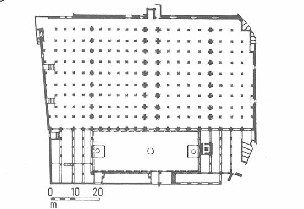 |
| Figure 3: General Plan of the Al-Qarawiyyin. |
Architecture of the Mosque
The mosque plan consists of three main sections. As noted above, the prayer hall (sanctuary) is the most historical part, being gradually developed and extended. It is of a rectangular shape stretching from the north to the west thus giving the Qibla side the longest breadth . The span of such space, 83x 44.2 meters, extends over 21 aisles running perpendicular to the Qibla wall, a reminder of the T plan seen in much of North African (Maghribi) mosques. The roof is made of a set of green tiled pyramids reflecting the number of arcades carrying it. The arcade itself is made of horseshoe arches supported by some 270 piers. The whole of the internal surface is painted in plain white, resembling the Kutubia Mosque and diverting from the rich decor of the Great Mosque of Cordova.
The central aisle or nave is wider and crowned with five cupolas of different styles mixing between ribbed and muqarnas vaulting, drawing the visitor towards the mihrab area. Further distinction of this aisle is noticeable in its pyramid roof, which was raised deliberately higher than the roof level of the mosque . As mentioned previously, it was added by Ali Ibn Yusuf's Andalusian architects. However, some doubted whether such a story is true. The six domes are not really Andalusian copies, especially the perforated ones. The muqarnas cupolas, executed in square, oblong and circular forms, are definitely older than their Andalusian counterparts[5]. In fact they are among the first muqarnas executed in North Africa by the Almoravids, next only to those introduced in Qala complex of Beni Ahmmad (1080) and Great Mosque of Telemcen (1082). Their development in North Africa coincided with their popularity in the Seljuk domain in Persia and Anatolia.
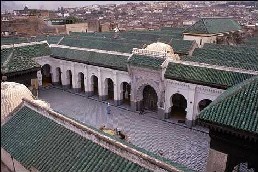 |
| Figure 4: General view showing the raising roof of the central aisle above the rest of the roof level. |
Tiled in blue and white, the courtyard lies in the western side of the mosque, equipped with three marble fountains. The central fountain is an original 12th century Almohad piece of furniture which was complemented by two lateral fountains fixed under two symmetrical patios that were built under the Saadid rule[6], by the Sultan 'Abdallah ibn al-Shaikh (r. 1606-23). With their slender marble columns, these kiosks are the most elegant part of the mosque . The sections above the capitals were sculptured in beautiful Moorish golden "embroidery" comprising exquisite floral and geometrical forms framed within bands of calligraphy, features recalling the Alhambra famous patio of Lions, which also became typical surface decor in the Saadid dynasty in Morocco.
 |
| Figure 5: The university is equipped with many instruments, especially those used in astronomy. The "timers room" is a chamber set up to accommodate these equipments including astrolabe, sand clocks and other instruments for the calculation of time. Above is one of the sundials fixed in a beautiful wall frame. |
The University
The foundation of the mosque was to provide, in addition to a space for worship, a learning center for the Qayrawaniyyin community. Like any mosque, Al-Qarawiyyin soon developed into a place for religious instruction and political discussion, gradually extending its education to all subjects, particularly the natural sciences. Among the subjects taught, alongside the Qur'an and Fiqh, were courses on grammar, rhetoric, logic, Medicine, mathematics, astronomy, chemistry and even history, geography and music . This variety of topics and the high quality of its teaching drew scholars and students from all over the Muslim world.
So overwhelming was the number of applicants that the university had to introduce a vigorous selection system based on a number of conditions, including a completion of learning the whole Quran from primary Madrassas and a good knowledge of Arabic and of general sciences.
The university gained the admiration of various sultans who did not delay in providing it with generous subsidies, gifts and sometimes with treasures, especially books. The university compiled an excellent selection of manuscripts in various disciplines, which were kept at a library founded by the Marinid Sultan Abu-Annan in the eastern side of the courtyard in 750 AH (1349 CE) before being relocated, towards the end of 1000 AH (1591 CE), in its present location by the Saadid Emir Ahmed Al-Mansur .Among the most precious manuscripts in this library are volumes from the famous Muwatta' Imam Malik (collection of hadith compiled by Imam Malik) (d.179AH/795CE) written on gazelle sheets, Sirat Ibn Ishaq written in 270AH (883 CE), a copy of the Holy Quran gifted by Sultan Ahmed Al-Mansur Al-Dhahabi to the university in 1011 AH (1602 CE), and the original copy of Ibn Khaldun's book KitabAl-'Ibar (Book of Lessons), gifted to the library in 799 AH (1396 CE).
Al-Qarawiyyin attained prestigious fame, producing a number of high profile scholars that exercised a strong influence on the intellectual and academic realms in the Muslim world. Among the great names, the list include Abu Abullah Al-Sati, Abu Al-Abbas al-Zwawi, Ibn Rashid Al-Sabti (d.721 AH/1321 CE), Ibn Al-Haj Al-Fasi (d.737 AH/1336 CE) and Abu Madhab Al-Fasi who led his generation in studies of the "Maliki" school of thought.
On the world stage, Al-Qarawiyyin played, in medieval times, a leading role in the cultural exchange and transfer of knowledge between the Muslims and Europeans. Pioneer scholars include Ibn Maymun (Maimonids), (1135-1204) who was taught at Al-Qarawiyyin by Abdul Arab Ibn Muwashah. The famous Al-Idrissi (d.1166 CE) is said to have settled in Fez for considerable time suggesting that he must have worked or studied at Al-Qarawiyyin. Sources also list a number of peers such as Ibn Al-'Arabi (1165-1240 CE), Ibn Khaldun (1332-1395 CE), Ibn Al-Khatib, Alpetragius, Al-Bitruji, Ibn Harazim, and Ibn Wazzan are said to have all taught in Al-Qarawiyyin[7]. Some historic accounts also spoke of Ibn Zuhr (d.1131 CE) spending a great deal of time travelling between Andalusia, Fez, and Marrakech.
Among Christian witnesses of the contribution of Al-Qarawiyyin is Gerbert of Aurillac (930-1003), famously known as Pope Sylvester II, and who is credited with introducing the use of zero and Arabic numerals to Europe, studied at Al-Qarawiyyin[8]. More recently the Belgian Nichola Louvain settled in Fez in 1540 and studied Arabic at Al-Qarawayyin, to be followed later by the Deutch Golius who also studied Arabic there.
Despite the above, such an enlightening institution was described by Lyautey, the French general who led the French "civilizing Mission" in Morocco as: "the Dark House", a comment which can only show the little respect he had for civilization.
[1] M2: Moroccan Television, (2003), `Masajid laha Tareekh; the Qarawiyyin Mosque', TV programme.
See also Marcais, G. (1954), `l'architecture Musulmane d'Occident', Arts et Metiers Graphiques, Paris, pp.198-200.
[2] where the anaza stands today
[3] Zenata
[4] Marcais, g. (1954), `L'Architecture Musulmane d'Occident', op.cit., p.199.
[5] See Jairazbhoy., p.92.
[6] lasted between 1554 and 1626.
[7] See Landu Rom (1967), `Afrique Mauresque', Albin Michel, Paris, p.97.
[8] Ibid. See also Glick.
( Reprinted from Muslim Heritage )
Wikipedia - University of Al Quaraouiyine
The University of al-Qarawiyyin or Al Quaraouiyine (Arabic: جامعة القرويين) is a university located in Fez, Morocco. It is the oldest existing, continually operating and the first degree awarding educational institution in the world according to UNESCO and Guinness World Records and is sometimes referred to as the oldest university.
Topics: Al Qarawiyyin University, Fez, Islamic Culture And Civilization, Morocco, Religious Education Values: Education
Views: 7261
Related Suggestions








